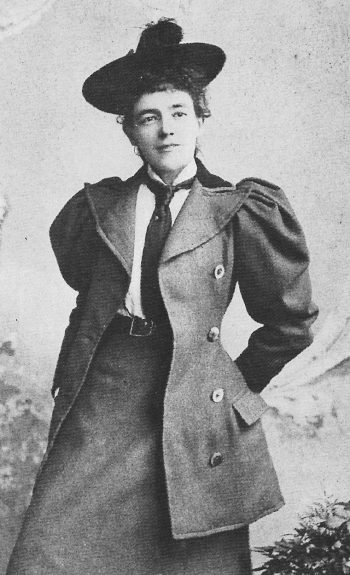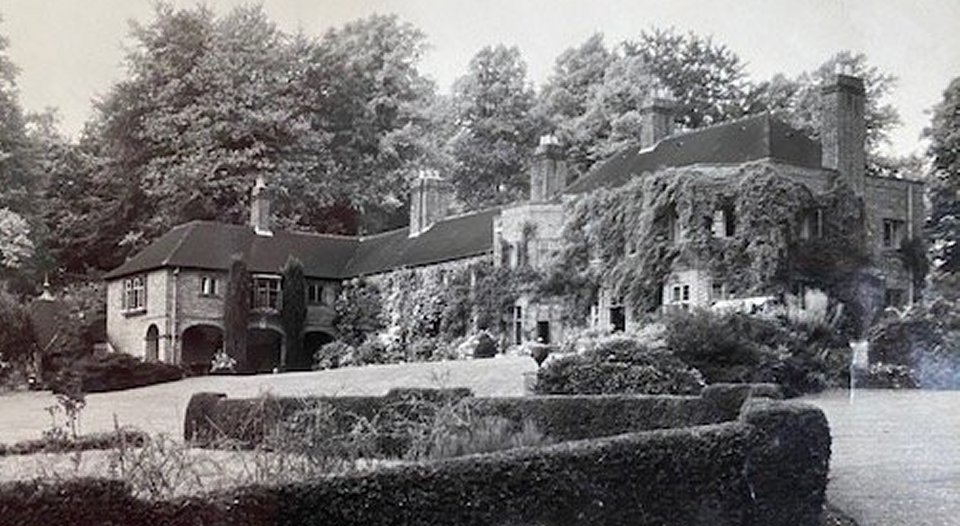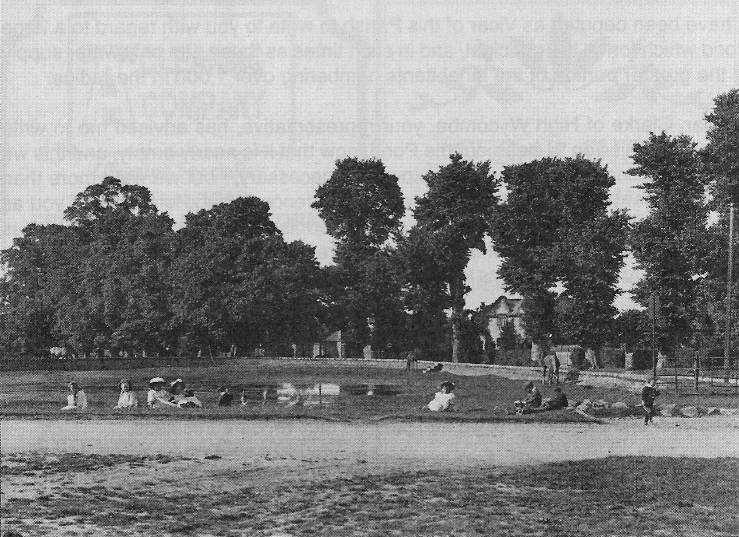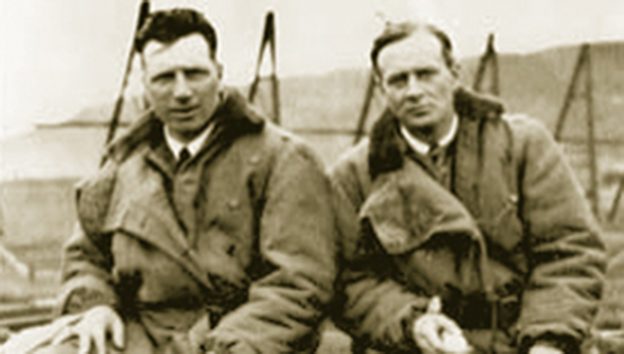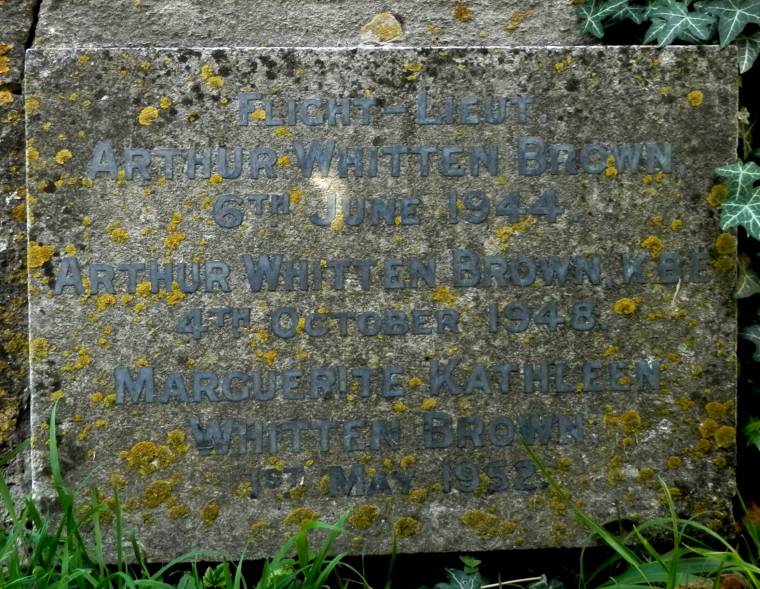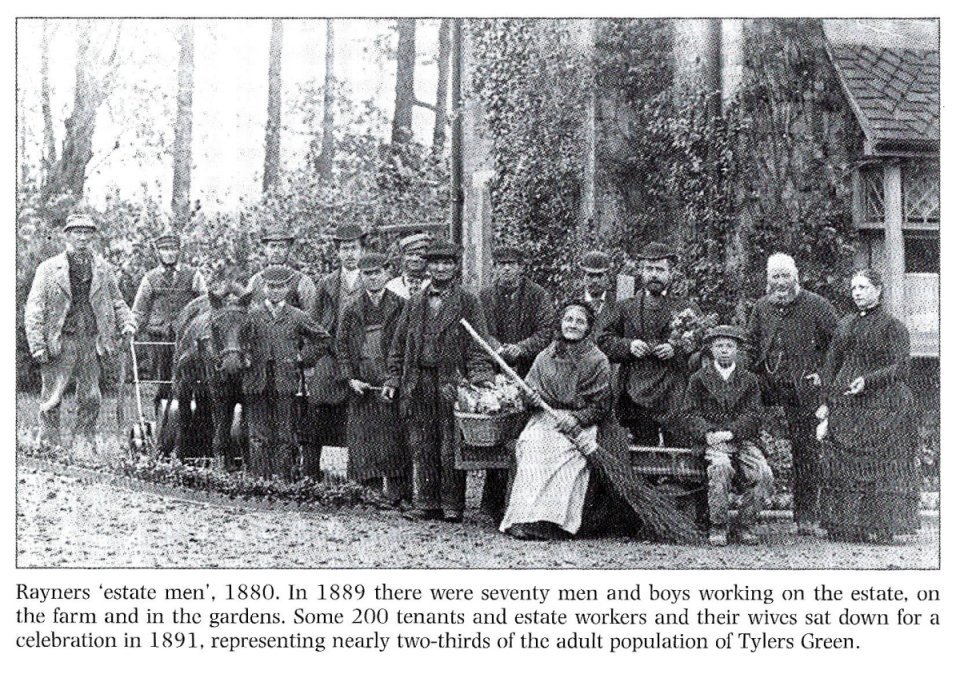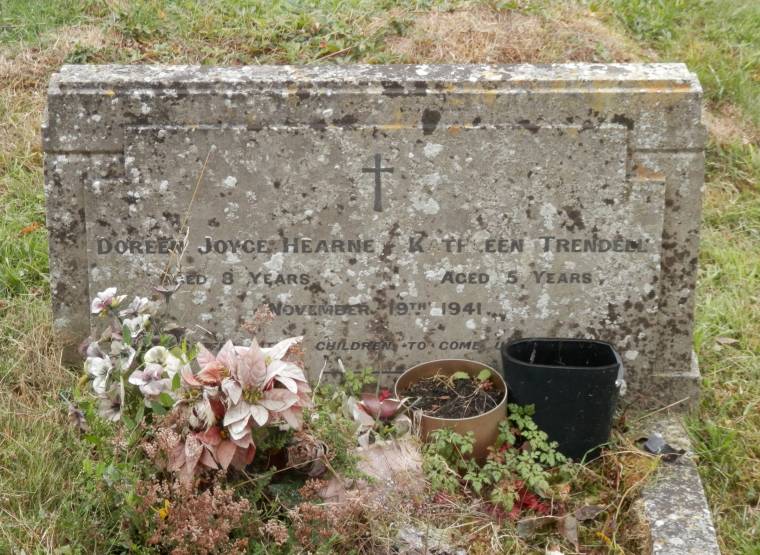Rev. Samuel S. Thorp has been Vicar of Penn and Tylers Green since June 2023 having previously served his curacy in Diss, Norfolk. He trained at St Johns, Durham, and before that spent five years at the London School of Theology. He loves theology, fantasy novels, poetry, walking, and minecraft.
Author Archives: tgweb
Constance Elfrida Ingpen / DelaMare
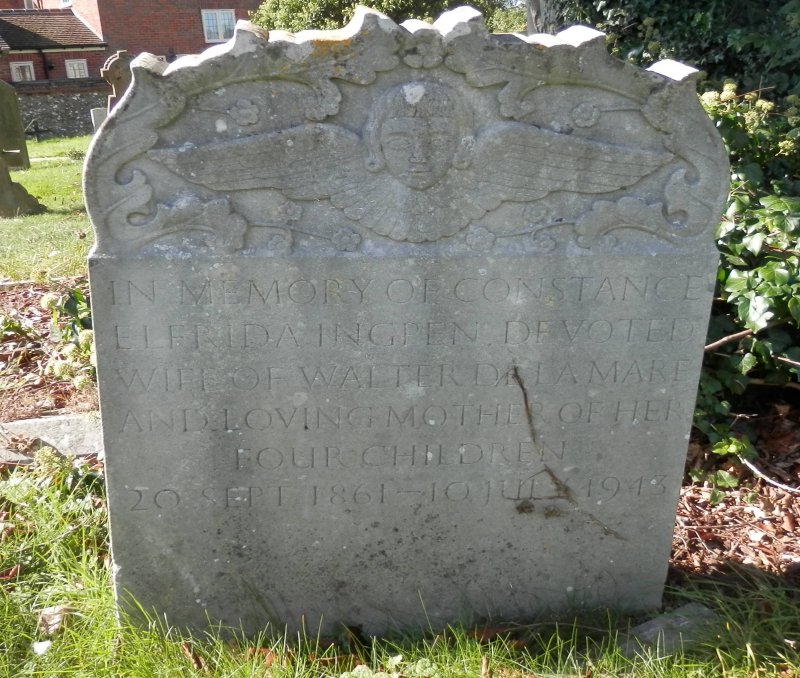 In front of St Margaret’s church, by the large war memorial beech tree, is a white gravestone ‘In Memory of Constance Elfrida Ingpen’. Not an instantly recognisable Tylers Green name. The inscription continues, ‘Devoted wife of Walter de la Mare, Loving mother of her four children, 20 Sept 1861 – 10 July 1943’.
In front of St Margaret’s church, by the large war memorial beech tree, is a white gravestone ‘In Memory of Constance Elfrida Ingpen’. Not an instantly recognisable Tylers Green name. The inscription continues, ‘Devoted wife of Walter de la Mare, Loving mother of her four children, 20 Sept 1861 – 10 July 1943’.
How did Walter de la Mare’s wife come to be buried in St Margaret’s churchyard?
Constance Elfrida Ingpen and the 20 year old Walter de la Mare met at the Esperanza drama group in Wandsworth in 1893.
Elfrida was their leading lady, the star of their productions, and Walter or ‘Jack’ (from his middle name John) was a junior clerk with the Anglo-American Oil company (later to become ESSO), and an aspiring author. In May 1894 Jack and Elfrida took leading roles in a play written by Jack, and although Elfrida was more than 10 years older than Jack they soon became an ‘item’. Elfrida, affectionately known as ‘Elfie’, had a hard childhood after both her parents died, she had been previously engaged, but her fiancée had died before they were married.
Walter and Elfie didn’t rush into marriage, mainly for financial reasons, and it wasn’t until the 4th August 1899 that they were married quietly at Battersea parish church. Walter continued working for Anglo-American until 1908 when his writing was producing enough income to support his wife and family of four small children.
They lived at various addresses in London and in 1925 moved to Hill House in Taplow which was to be their home until 1939. Hill House now has a blue plaque.
In September 1939 Elfrida suffered a pulmonary embolism, only days after war had been declared. Elfrida and Walter were invited by their eldest daughter Florence and her husband Rupert to stay with them at the Old Park, Hammersley Lane, for Elfrida to convalesce. Walter and Elfrida gave up Hill House, and moved their home to a flat in Twickenham where they thought Elfrida would be better able to manage as her health improved. Unfortunately she never fully recovered and also developed Parkinsons Disease. Elfrida and Walter spent most of their time living with Florence and Rupert at the Old Park to be safe from the constant air raids on London.
The 1939 register shows 20 people living at the Old Park. Florence and her husband Rupert Thompson and their children, four domestic staff, Walter and Elfrida and three other aged Ingpen relations, plus a school teacher and three children with different surnames, presumably evacuees. Their neighbour at Rathenrae, (now Folly Meadow), across Hammersley Lane, the Indian princess Sophia Duleep Singh also had three evacuee children. Their next-door neighbour at Colehatch House was Sophia’s sister Catherine. After her sister’s death in 1942, Sophia renamed Colehatch House to Hilden Hall as a tribute to her sister, Hilda was Catherine’s middle name, although another suggestion is that it was named after a place where they had lived in Germany.
Elfrida died on the 10th of July 1943, and was buried at St Margaret’s. A little known connection between Tylers Green and Walter de la Mare and his family. Walter died in 1959 and is buried in St Paul’s Cathedral where he was a choir boy.
Acknowledgements to the excellent biography of Walter de la Mare, by Theresa Whistler which has a few photographs taken at the Old Park, although the original house was completely rebuilt a few years ago in a very modern style.
Peter Strutt, St. Margarets and Holy Trinity Penn Parish Newsletter, February 2018
(Elfrida and Old park photographs from ‘The Life of Walter Delamere’, Theresa Whistler)
An extract from the biography of ‘Sophia’, by Anita Anand, p.367.
‘One time in 1942 I think, we were late back … The princess was waiting for us as usual, and demanded to know where we had been,’ recalled Shirley (the eldest evacuee child). ‘We told her a nice old man had stopped us on the way home and wanted to know all about us … She was furious. She told us never to talk to strangers again, and got straight on the phone to the local policeman. She must have given him quite the earful because he was off on his bike immediately, huffing and puffing up and down the lane to investigate. It turned out the old man was Walter de la Mare, who was staying with his daughter in Penn. He was working on a poem about evacuees. We felt terrible for the trouble we caused for him. Poor man got the fright of his life!’
Eliabeth von Arnim – Author of ‘Elizabeth and her German Garden’
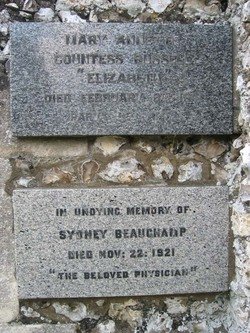 As you walk into St Margaret’s Church from Hammersley Lane, you will see two small stone tablets on the far left outside corner of the church, one above the other. The lower one is inscribed ‘Sydney Beauchamp, ‘the Beloved physician’. The upper one says ‘Mary Annette Countess Russell, ‘Elizabeth’, Parva sed apta’.
As you walk into St Margaret’s Church from Hammersley Lane, you will see two small stone tablets on the far left outside corner of the church, one above the other. The lower one is inscribed ‘Sydney Beauchamp, ‘the Beloved physician’. The upper one says ‘Mary Annette Countess Russell, ‘Elizabeth’, Parva sed apta’.
Who were they?
Sir Sydney Beauchamp (1861-1921) was a distinguished doctor whose career high point was as the resident Medical Officer to the British Delegation during the peace Conference in Paris in 1919. His local connection was that he built Salter’s Meadow in Beacon Hill, in 1902, on six acres of land, the first sold by the Penn Estate to meet death duties after the third Earl died in 1900. He was killed in a street accident in London in 1921.
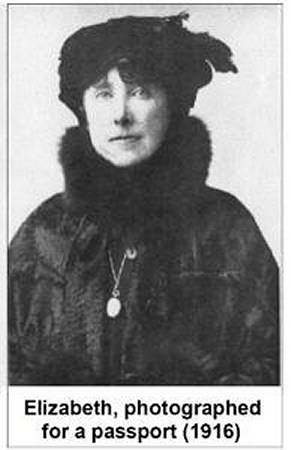 Elizabeth Russell (1866-1941) was his devoted younger sister. She was born Mary Annette Beauchamp and married a Prussian aristocrat, Count von Arnim, in 1891, by whom she had four daughters and a son. She became an overnight sensation when her first semi-autobiographical novel, Elizabeth and her German Garden, was published anonymously in 1898 and was reprinted 21 times in the first year. From then on, writing became a central part of her life and 20 novels followed, all described as ‘by the author of Elizabeth and her German garden.’
Elizabeth Russell (1866-1941) was his devoted younger sister. She was born Mary Annette Beauchamp and married a Prussian aristocrat, Count von Arnim, in 1891, by whom she had four daughters and a son. She became an overnight sensation when her first semi-autobiographical novel, Elizabeth and her German Garden, was published anonymously in 1898 and was reprinted 21 times in the first year. From then on, writing became a central part of her life and 20 novels followed, all described as ‘by the author of Elizabeth and her German garden.’
Her husband died in 1910 and she returned to live partly in England and partly in Switzerland. The First World War trapped two of her daughters in Germany and she herself, also a German citizen, only got back from Switzerland at the last minute using a passport lent by one of her brother’s patients. Her other two daughters, born in Berlin and with guttural German accents, had to report weekly to a police station and their Uncle Sinner (Sydney) arranged for them to work as nurses in a London hospital. In 1916, she married for the second time, to the second Earl Russell, Bertrand Russell’s elder brother. It was not a success and they separated after three years with Elizabeth seeking refuge with her brother, as she always did in times of crisis, describing him as an angel. He had delivered three of her children.
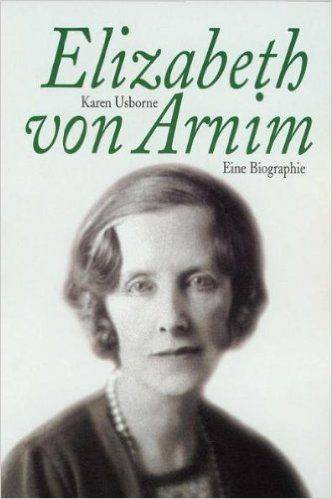 She was a very attractive personality, intensely vivacious with an impish, sometimes cruel wit and a circle of devoted friends and admirers. Her children’s tutors included the young E.M.Forster and Hugh Walpole and she had an affair with H.G.Wells. She was close to her children, particularly in her later years and greatly missed her brother after his untimely death. She died in 1941 at the age of 75 in the USA, after catching a cold, and it was not until 1947 that her daughter was able to bring her ashes back to England for burial next to her brother in St Margaret’s. She had chosen the inscription, ‘Parva sed apta’, ‘small but capable’, which described her precisely.
She was a very attractive personality, intensely vivacious with an impish, sometimes cruel wit and a circle of devoted friends and admirers. Her children’s tutors included the young E.M.Forster and Hugh Walpole and she had an affair with H.G.Wells. She was close to her children, particularly in her later years and greatly missed her brother after his untimely death. She died in 1941 at the age of 75 in the USA, after catching a cold, and it was not until 1947 that her daughter was able to bring her ashes back to England for burial next to her brother in St Margaret’s. She had chosen the inscription, ‘Parva sed apta’, ‘small but capable’, which described her precisely.
A final intriguing twist to the tale is that she may have lived at some time in St Margaret’s Cottage next door to Threshers (now ‘The VILLAGE SHOP on the Green’) on School Road. In 1960, when the one large house was split into two by Veronica Papworth, a well-known fashion commentator and illustrator (who lived at Stonehouse in Penn from 1953), she called one Elizabeth’s Garden and the other Elizabeth Cottage (they are now St Margaret’s and Silvester Cottage). She told me many years later that she had seen Elizabeth von Arnim’s name on the deeds and she was clearly convinced of the connection. I have to say that the name is not on any deeds that I have seen, but the house was let for many years and Elizabeth would have been a tenant. Nor, oddly enough, is there any mention of visits to Penn or Tylers Green in her biography (by Leslie de Charms, Heineman 1958). Her brother also had a flat in London, but it seems very unlikely that she did not visit her brother at his country home.
Miles Green, October 2006
When the Village Pond was our only Water Supply
Village historian Miles Green has unearthed the following letter from the files of the Church Commissioners in London. It was written by the Rev. Ashley Spencer, vicar of Tylers Green from 1883 to 1918 (Ashley Drive is named after him), and it illustrates just how important Widmer Pond – the pond on the common – was to villagers at the time, because it was the only water supply for the population. Unlike today, ducks were positively discouraged because they could contaminate the water.
The letter – reprinted exactly as written – was written to the pond’s owners at the time, the Ecclesiastical Commissioners, on June 11th 1893. It reads:
“I have been deputed as Vicar of this Parish to write to you with regard to a large Pond which forms the principal, and in such times as these, the only water supply of the greater portion of the inhabitants numbering over 1,000 in the radius.
Mr Dan Clarke of High Wycombe, your representative, has advised me to write for your permission to clean out the Pond, now that it is nearly empty, and this we are quite willing to do, at our own expense if necessary, – but we want more than this – we want to put it in thorough repair, and fence it round etc., etc. If you as Lords of the Manor will not only give us the permission to do so, but will also (as you have done in the case of the Common here) take it under your protection, and put up a board similar in Terms to that you have had put up to preserve the Common.
The Pond is called Widmer Pond and is just on the borders of High Wycombe Civil Parish – indeed the boundary line between the Unions of Amersham and Wycombe passes through the middle of the Pond. In times past we have spent over £200 on the Pond and Pump, with the most unsatisfactory results as the Pump has been destroyed, and the filter tank we had put in is thus rendered useless.
Both Sir Philip Rose and I feel it is useless to spend any more money on it as private individuals, unless and until the Pond is properly protected as belonging to some public body who will if necessary prosecute offenders.
I shall be up in Town on Thursday morning, and could call to see you and explain more fully, if you could arrange to see me say at any time from 10.30 to 11.30 or 10 to 11.
The matter is urgent for we have a water famine here now, and want to prevent such a thing happening again, if we can, by making the Pond once more sound and Clean.
I should be very glad of an answer by return, at all events giving us leave to Clean the pond, and the rest could wait until I have seen you. Our meeting last night was a representative one – and we have adjourned until next Saturday, when I hope to be able to report favourably the results of my application.
I remain Gentlemen Yours very faithfully, R.F. Ashley Spencer. Vicar of Tylers Green
The vicar was successful in his plea, although a fence was never erected.
Miles Green, Village Voice 71, Feb/March 1999
Sir Arthur Whitten Brown
Alcock & Brown – the first flight non-stop across the Atlantic
It may come as a surprise to many people that there is a small memorial stone to Sir Arthur Whitten Brown on the very bottom of the SW buttress to the nave of St Margaret’s Church in Tylers Green.
On June 14th 1919, the first non-stop flight across the Atlantic was accomplished by John Alcock (pilot) & Arthur Brown (navigator) with no modern aids, a damaged exhaust and a non-functioning wireless. They took off from St John’s, Newfoundland in the open-cockpit modified version of a WW 1 Vickers Vimy twin-engined bomber and landed 1880 miles and 16 hours later in Connemara, Ireland. This is the account my elder son, then aged 12, wrote for Village Voice 20 years ago.
‘As there was no compass in the craft they had to take their bearings from the stars. It was very cloudy which meant they only had four chances to take a bearing from the stars. The first bearing was taken after six hours. Five hours later they ran into very thick cloud. Alcock, who was piloting at the time, did not even know which way his plane was going. Suddenly it stalled and fell toward the sea. Only 150 meters above the waves the clouds parted and Alcock was able to gain control.
 An hour later they ran into snow and Brown had to keep climbing out of the cockpit onto the very slippery fuselage to wipe snow and ice off the engine air intakes. Next morning, after 16 hours 30 minutes (at an average speed of 115 mph), they crash landed into a bog in Ireland’ (thinking it was a green field).
An hour later they ran into snow and Brown had to keep climbing out of the cockpit onto the very slippery fuselage to wipe snow and ice off the engine air intakes. Next morning, after 16 hours 30 minutes (at an average speed of 115 mph), they crash landed into a bog in Ireland’ (thinking it was a green field).
The first to greet them were staff from the Marconi radio station who refused to believe the fliers when they insisted ‘We are Alcock and Brown. Yesterday we were in America’.
It was a triumph of navigation, flying skill and rare courage for which they were both knighted by George V a few days later. They also won a Daily Mail prize of £10,000.
Alcock was killed only 6 months later when the plane he was flying to the Parish Air Show, crashed in fog. Three days earlier he had been at the Science Museum for the presentation of the plane in which they had made the crossing. A new book about the flight, by Brendan Lynch, Yesterday we were in America, is due out later this month (i.e. in 1989).
The memorial stone, which has been moved – originally it was just to the west of the main door – also records the names of his wife and only son who was killed on D-day, 6th June, 1944, aged 22, flying a Mosquito fighter-bomber over Holland. Sir Arthur was an American by birth, but was brought up in England and took British citizenship when he joined up in 1914. He died in his sleep on 4 October 1948 from an accidental overdose of Veronal, aged 62. His wife, Kathleen Kennedy came from Sweethope Cottage in Manor Road which is about a mile from St Margaret’s.
Arthur Whitten Brown
6th June 1944
Arthur Whitten Brown K.B.E.
4th October 1948
Marguerite Kathleen
Whitten Brown
1st May 1952
Henry Cakebread (1836-1926)
ASK THE VV HISTORIANS
The VV ‘Ask the Historians’ were approached by the great grand-daughter of Henry Cakebread the former Head Gardener of Rayners) who was looking to learn more about her great grandfather.
‘ … .I would like to know more about Rayners estate. My great-great-grandfather Henry Cakebread worked as a gardener on the estate circa 1881 and was Estate Steward of Rayners and lived in Rayners Lodge in 1901. I am trying to find as much information as I can …..
Henry Cakebread (1836-1926)
Study any list of names from 120 years ago containing the men who made Tylers Green thrive, and you will be sure to see that of Henry Cakebread, Churchwarden and Estate Steward to Sir Philip Rose of Rayners. Unlike many of his contemporaries Henry was not Bucks born nor were any of his seven children born or baptized within the County.
Henry was born 30th Jan 1836 at a time when Viscount Melbourne was Prime Minister and William IV still on the throne, in Hatfield Broad Oak Essex (not to be confused with the town of Hatfield in Hertfordshire). Hatfield Broad Oak stands to-day adjacent to Stansted Airport. Little is known of his early life except that his family worked on the land in rural Essex. Drawn to South London in the 1850’s and residing in Coopers Row Brixton Hill and working as a gardener, a trade he was to follow for the rest of his life, he married Mary Ann Maria Livermore from Teddington on Thursday 15th July 1858 at Christ Church Streatham. Three years later he was domiciled at 2 Champion Terrace Lambeth now with the first of his children, James born May 1859 in Clapham and Elizabeth following in 1860 in Brixton.
By 1871 he had moved to the more rural surroundings of Ham in Surrey, maybe he worked at Ham House, with his family nearly complete, four more children having been born in the preceding decade. Henry in 1862, Charles in 1864 Emily in 1867 and Edith in July 1868. At some point in the next ten years, he made the move which was to shape the remaining years of his life. In 1881 census at the age of 45 he and his wife and two of his children are recorded in “The Lodge to Rayners Tylers Green Chepping Wycombe,” gardener to Sir Philip Rose.
Lucy his seventh and last child had arrived in 1875 like her two older sisters Emily and Edith she had been born when the family were living in Ham. His older children had already married and moved on by the time the move to Bucks occurred, James had married Emily Eliza Adams in June 1878 in St. Anne’s Westminster and was working as a plumber in Deptford, he died in 1913 still a plumber and probably in the employ of the London Brighton & South Coast Railway Co. They had 6 children. His second child, Elizabeth Mary never married and ended her days in Pound Hill Witchampton, Dorset, where she had been the village schoolmistress. She was just 59 when she died in the Church Street Surgical Home in Bath.
In the 1860’s Henry & Mary had spent some time living and working in Tupsley Herefordshire which is where his next two sons were born, Henry in 1862 and Charles in 1864. We lose sight of Henry junior after the 1881 Census when he was living in Tulse Hill South London and working as a railway clerk, he does not appear on any later census nor is there any trace of a marriage or death.
His younger brother Charles by comparison travelled extensively in the British Isles, after marrying Elizabeth Woodyatt in Chorlton Lancashire in the summer of 1892, they lived in Edinburgh in 190 I and moved to Withington Manchester a decade later, they spent World War 2 in Urmston Lancashire, he died in April 1957 aged 93, they had no children and his whole working career like his father was spent as a gardener.
Monday 18th October 1897 must have been a memorable day for St. Margaret’s, Tylers Green as two of Henrys daughters Emily & Edith Harriett married two brothers Frederick Henry & Herbert Frank Tester, they were both grocers from Kent & Sussex respectively which is where the Cakebread daughters later made their home. It is worth recording that a witness a both weddings was Rose Annie Rose, Sir Philip’s wife.
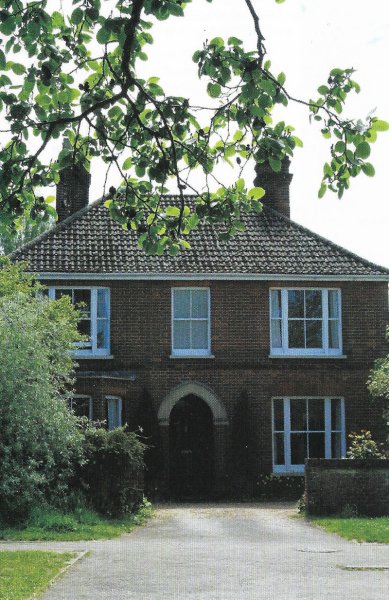 By the turn of the 20th Century, he is still living in Rayners Lodge but now bearing the job title Estate Steward and indeed a man of some standing in the local community. Of his children only Lucy now aged 26 remained at home. She along with her father involved themselves in the community notably the Tylers Green Sports Day she on the organising committee and he as a judge. Sir Philip thought so highly of him that he built a house in the centre of the village which still stands to-day, to the right hand side of the First School, when built it was known as The Hawthorns, to-day it carries the name St. Enodoc (The church in Cornwall where John Betjeman is buried).
By the turn of the 20th Century, he is still living in Rayners Lodge but now bearing the job title Estate Steward and indeed a man of some standing in the local community. Of his children only Lucy now aged 26 remained at home. She along with her father involved themselves in the community notably the Tylers Green Sports Day she on the organising committee and he as a judge. Sir Philip thought so highly of him that he built a house in the centre of the village which still stands to-day, to the right hand side of the First School, when built it was known as The Hawthorns, to-day it carries the name St. Enodoc (The church in Cornwall where John Betjeman is buried).
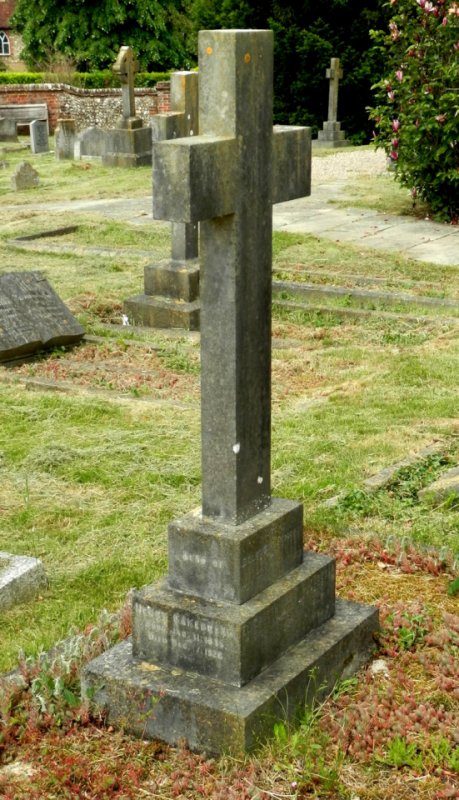 January 1926 saw the death of his youngest child Lucy Maria in the Wycombe War Memorial Hospital aged of just 56. Henry followed her later the same year dying seven days before Christmas 1926 at his home in School Road Tylers Green, he was 90 years old, his wife Maria survived him by two years before her death in October 1928 at the age of 94. All three lie together in a substantial grave marked with a cross just on the left before you enter the porch at St. Margaret’s on the path from Hammersley Lane and in the shadow of the Church to which he had been elected Churchwarden no less than 18 times.
January 1926 saw the death of his youngest child Lucy Maria in the Wycombe War Memorial Hospital aged of just 56. Henry followed her later the same year dying seven days before Christmas 1926 at his home in School Road Tylers Green, he was 90 years old, his wife Maria survived him by two years before her death in October 1928 at the age of 94. All three lie together in a substantial grave marked with a cross just on the left before you enter the porch at St. Margaret’s on the path from Hammersley Lane and in the shadow of the Church to which he had been elected Churchwarden no less than 18 times.
Ron Saunders, Village Voice edition 204, June/July 2021
Memories of a Local tragedy
A recent visitor to Penn House who knew it as a schoolboy during the War drew my attention to a terrible event which occurred in Penn nearly eighty years ago and is now half-forgotten: the brutal murder of two small girls.
On 19th November 1941, Kathleen Trendell, aged nearly 6, and Doreen Joyce Hearne, aged 8, emerged from the gates of the village school and wandered together towards the Parish Room, where an army lorry was parked. Recognising the driver from a previous encounter, they asked him to give them a ride and proceeded to climb aboard: the lorry then drove away. It was not until later that evening that the girls’ anxious parents reported their absence to the police.
A huge search of the area was instigated, helped by many local residents. For three days no trace of the girls could be found. Then on 22nd November came a shocking discovery. The girls’ bodies were found in some rough woodland near Mop End. Each of them had been strangled and repeatedly stabbed through the neck. Amongst the first on the scene were several boys from Emsworth House School, at that time located in Woodrow. The sight of the mutilated bodies left some of them traumatised for many weeks.
Thanks to detailed descriptions of the lorry, as well as forensic evidence gathered near the bodies, the police, led by Chief Inspector George Hatherill of Scotland Yard, were rapidly able to home in on the chief suspect; 26-year-old Gunner Harold Hill of 86th Field Regiment, Royal Artillery, based in Suffolk. The combination of evidence, which included fingerprints, was damning. In early 1942 Hill was tried at the Old Bailey and found guilty. He was hanged at Oxford Castle a few weeks later.
On 27th November a special service of remembrance was held in St Margaret’s Church attended by the whole of the Village School. Afterwards the two girls were given a joint funeral and buried together in the churchyard. For the Village, the shock was profound: at a time when newspaper columns were dominated by the War, the tragedy of the murders plunged the residents of Penn and Tylers Green into grief as few events have since.
Frederick Howe, Village Voice, September 2018
The 1910 Election Campaign
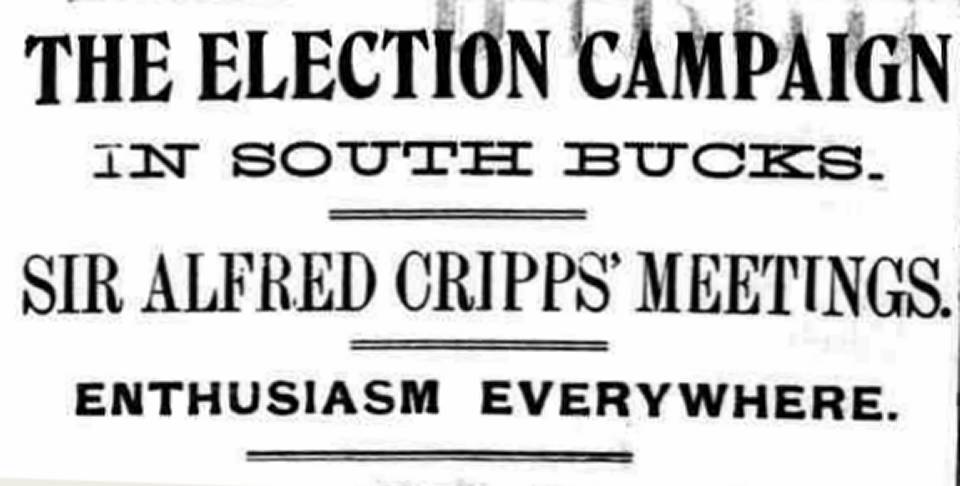
From the South Bucks Standard, January 7th 1910.
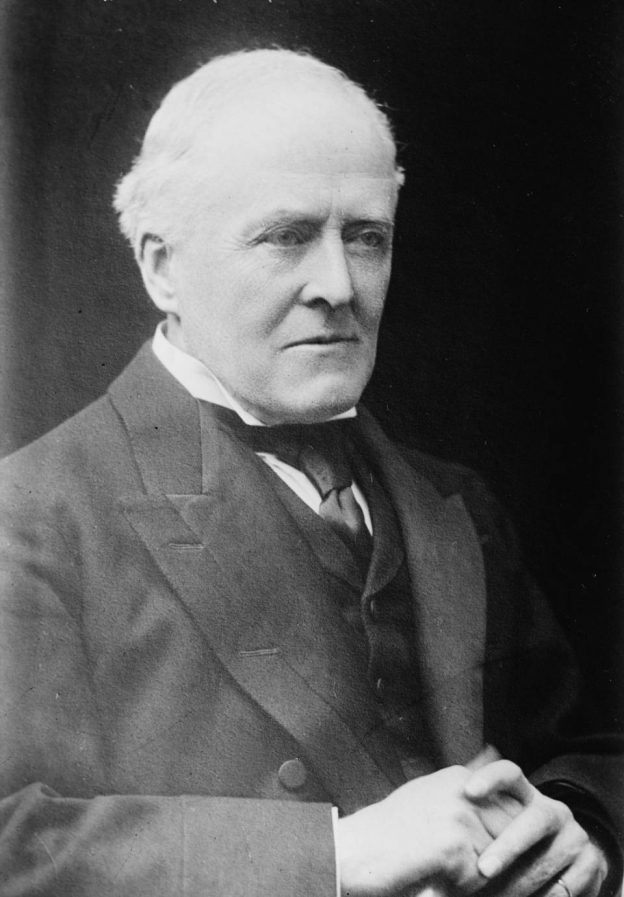 Sir Alfred Cripps stood as Liberal candidate for the Wycombe constituency in the 1910 General Election. The newspaper reported the many meetings he held across South Bucks, including ones at Penn Street and Tylers Green.
Sir Alfred Cripps stood as Liberal candidate for the Wycombe constituency in the 1910 General Election. The newspaper reported the many meetings he held across South Bucks, including ones at Penn Street and Tylers Green.
He was elected as MP for Wycombe at the 1910 General Election, but was raised to the peerage by the Liberal party in 1914, prompting a by-election. He took the title Lord Parmoor, the name of the village where he lived, in his Wycombe constituency.
His youngest son Sir Stafford Cripps, became a Labour politician who served in the 1945 post-war Labour Government.
There is a family history written by his son on the Frieth and Parmoor website.



